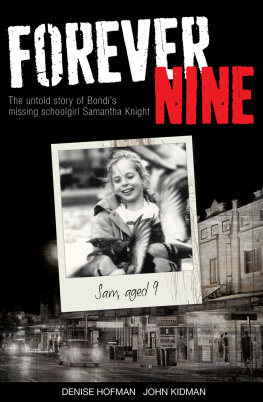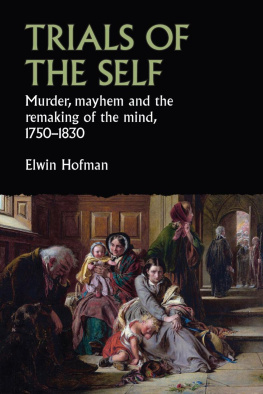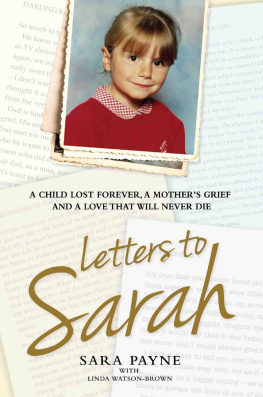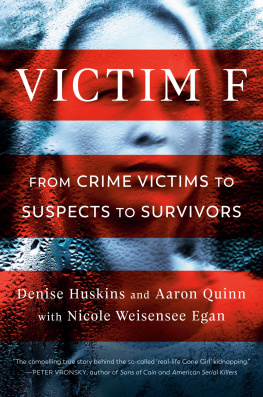About the Authors
Denise Hofman is a former teacher and community advocate for the protection of Aboriginal heritage and culture, focusing on the degradation of Sydneys Hawkesbury Nepean River system, which was under threat from the state governments North West Sector Housing Development. It was during this period in the early 1990s that she met Michael Guider, an amateur archaeologist, and together they recorded numerous Aboriginal sites. After Guider was charged with child sexual assault in 1996, Denise assisted police with their investigation into Samantha Knights disappearance. Denise is married with five children and lives in Sydney.
John Kidman has spent almost 20 years as a Sydney print journalist. After leaving an on-air job in country radio in 1994 he worked with Australian Associated Press for seven years, specialising in the police round. He tried his hand as a water polo writer during the Sydney Olympic Games before moving to the Sun-Herald as the papers police reporter. For the next eight years he worked on some of Sydneys biggest crime stories, winning recognition as a Walkley Awards finalist. In 2012, he returned to AAP as part of their production team. John is married with four children.
Authors Preface
When a friend first put me in touch with Denise in the mid-2000s, Michael Anthony Guider had already been behind bars for ten years. However, Denise was adamant more could be done to somehow get him to reveal the location of Samanthas grave.
We collaborated on a feature article for the Sydney Sun-Herald , where Id spent the previous five years as the papers police reporter. The article focused on Denises long struggle to persuade senior cops of Guiders culpability, and raised the spectre of his knowledge of and involvement in other cases.
A follow-up piece hammered home similar themes, but Denise was keen on the possibility of the two of us writing something more substantial; laying everything out, as it were, so that people could make up their own minds about just how much more there was to the story. She was, in fact, already working on a fairly lengthy account of her own role in the affair but had realised the project was calling out for a more journalistic feel.
The timing wasnt quite right and the idea was left to gather dust until I decided to quit Fairfax and go on to something new. When I came on board, we agreed above all to try to tell the real story of what happened on 19 August 1986, the story Michael Anthony Guider had for so long denied and concealed Samanthas story.
It was an undertaking that might well have fallen short if not for a startling find. Having acquired access to transcripts of Guiders pre-trial court hearings, we discovered among them a series of long-forgotten statements provided by witnesses to Sams last known moments on Bondi Road. Missed by the media of the day, theyd simply been filed away in storage with the rest of the evidence against Guider once hed opted to plead guilty to manslaughter in 2002.
Read in careful sequence, they took our breath away. As though raising the curtain on a 20-year-old mystery fraction by fraction, each account effectively placed Sam in a precise location along the busy section of the street at a certain time during the afternoon. Some remarked on her clothes and hair, others on where she seemed to be heading and what she was doing.
Then, to our amazement, we realised that Guider was right there with her, in the descriptions. Passersby had noticed a man matching his appearance standing beside her on the footpath while people in vehicles stuck in peak-hour traffic had similarly described him staring at or approaching her.
Although the police had been unable to see him, Sams killer had been in plain view all along.
Much else came into focus as we looked deeper and deeper into Michael Guiders background and, eventually, the social connections that brought Samantha into his orbit. One thing we learned along the way was just how many other lives he managed to irrevocably damage before committing the ultimate crime. We have tried to give them a voice as well.
Denise has been wonderfully patient during the times I have been unable to devote as much energy to the task of researching and writing as it demanded. She has always remained as steadfastly determined to see the project completed as the day we started.
She hasnt communicated with Guider in more than a decade and is not likely to again. Yet she is deeply concerned about the possibility of him being released on parole, something he will undoubtedly apply for when he becomes eligible in 2014. He will be 64.
John Kidman
Introduction
Samantha Knight loved her mum Tess, her cat Midnight and the Raggedy Ann doll that sat on her bed, Juliet. Her dad, Peter, didnt live with them any more but she loved him too. Her favourite book was an Australian classic called Playing Beattie Bow about an inquisitive little girl not too unlike herself. She collected stickers and rocks and was fond of strumming her guitar and playing dress-ups and board games. Samantha also liked school a lot and everyone thought she was clever, pretty and friendly. She was a sweetheart.
In 1986, Sam was nine years old and happily residing in Bondi, home to the most famous of Sydneys sparkling eastern beaches. On a cool, damp August evening that year, however, just a short walk from her front door, she vanished. When no trace of her was found, a wave of public disbelief and sympathy erupted. It was an outpouring that quickly gave way to tremendous anger and fear once the realisation set in that she was never coming home. At the time, perhaps only the heartbreaking abduction of the Beaumont children two decades earlier in South Australias capital, Adelaide had triggered more widespread anguish.
None of this emotion, though, could bring Sam back. For generations of Sydneysiders, her angelic image, staring out from a million missing-person flyers, would stay so, forever frozen. In the days and weeks after she disappeared, these flyers were plastered on power poles, walls and billboards across the city and sent thousands of kilometres beyond. Long ago rendered sepia by countless summer days, some could still be found stuck inside shop windows years later.
The search for the petite primary schooler was the largest and most intensive ever undertaken by New South Wales Police. Yet it was doomed to fail: by the time the frantic effort began, Samantha was almost certainly already dead.
Successive investigations into the circumstances of Sams fate were similarly fruitless. The men and women who conducted them looked in the wrong places and from the wrong beginnings. While they spent themselves trying to solve a random kidnapping the most obscure and difficult of all cases to crack Sams disappearance was no such thing.
Samantha knew her killer well. The simple version is that before moving to Bondi, Tess and Sam had lived on the citys northern peninsula where hed been her best friends babysitter. The arrangement allowed the other little girls mother, a single parent like Tess, to have a night off. Without Tesss knowledge, let alone her consent, the bloke had also been trusted to mind Sam during a number of weekend sleepovers. And on several of the Friday or Saturday nights in question, another of her daughters playmates was invited over and quietly left in the sitters care as well.
The circumstances were undoubtedly odd a single man in his mid-30s, childless and unrelated to any of the girls, watching over three primary school friends. However, the fact no one else was told about the arrangement by the woman who organised it whatever her reasons went beyond what was acceptable by anyones standard. She claims she never left the girls alone with the man but too many others simply say that she did.










![Denise R. Jacobs [Denise R. Jacobs] - CSS Detective Guide: Tricks for Solving Tough CSS Mysteries, ePub, The](/uploads/posts/book/119154/thumbs/denise-r-jacobs-denise-r-jacobs-css-detective.jpg)

